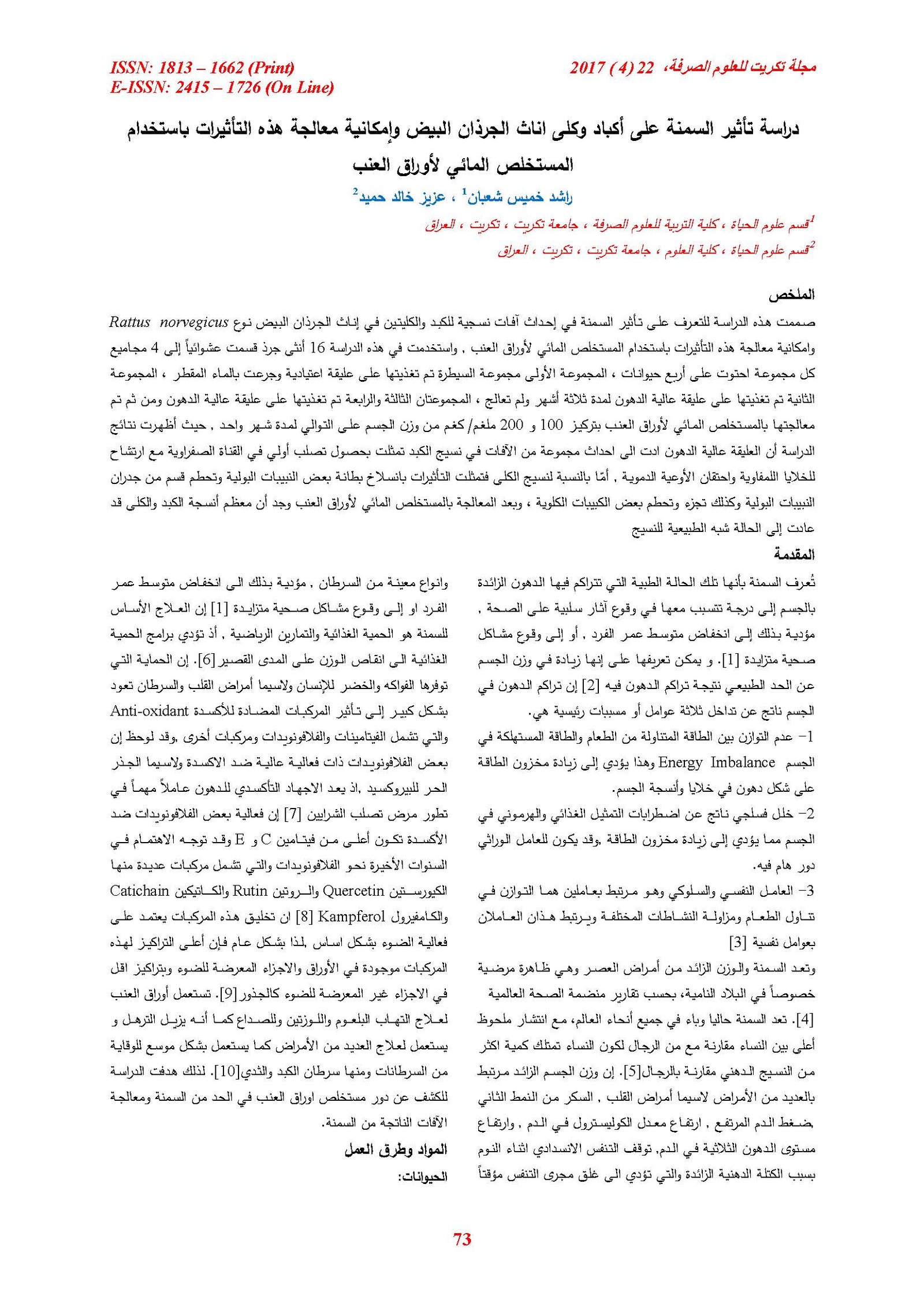Study the obesity effect on liver and kidney tissues of female rats followed by treatment these effects by using aqueous extract of grape leaves
Main Article Content
Abstract
The present study was designed to identify the effect of obesity for induction histological lesions to liver and kidneys in female rats Rattus norvegicus. and treated with herbal therapy (aqueous extract of grape leaves) The present study used 16 female rats which distributed randomly into four groups (each group containing four female) the first group was control group administrated only normal diet and water, the second group was fed a high fat diet for three months without treatment, the third and fourth groups fed a high fat diet for three months and treated with aqueous extract of grape leaves100 and 200 mg / kg of body weight respectively for one month. The results showed that the effect of a high fat diet on the liver included primary seclerosing bile ducts, infiltration of lymphocytes and congestion of blood in the blood vessel with the absence of cellular arrangement of liver tissue, while the kidney tissue show desquamation epithelial lining cells in some tubules with damage of some renal glomeruli. When the aqueous extract of grape leaves used, most tissues in the liver and kidneys back and appear semi-normal state.
Article Details

This work is licensed under a Creative Commons Attribution 4.0 International License.
Tikrit Journal of Pure Science is licensed under the Creative Commons Attribution 4.0 International License, which allows users to copy, create extracts, abstracts, and new works from the article, alter and revise the article, and make commercial use of the article (including reuse and/or resale of the article by commercial entities), provided the user gives appropriate credit (with a link to the formal publication through the relevant DOI), provides a link to the license, indicates if changes were made, and the licensor is not represented as endorsing the use made of the work. The authors hold the copyright for their published work on the Tikrit J. Pure Sci. website, while Tikrit J. Pure Sci. is responsible for appreciate citation of their work, which is released under CC-BY-4.0, enabling the unrestricted use, distribution, and reproduction of an article in any medium, provided that the original work is properly cited.
References
1- Haslam, D.W. and James, W.P. (2005): Obesity .Lancet 366 1197-1209.
3- Bhargava , A .(2003). " Alongitudinal analysis of the risk factors for diabetes and coronary heart disease in the Framingham offspring study "population health metrics , 1 (3) ; 1 ;10, .
4- Heshka, S. and Allison, D. B. (2001). Is obesity a disease?. Int. J. of Obesity, 25: 1401-1404.
5- Dennedy, M.C.; Dunne, F. (2012).The maternal and fetal impacts of obesity and gestational diabetes on pregnancy outcome. Best Practice & Research Clinical Endocrinology & Metabolism. ;24:573–589.
6- Strychar, I. (2006). "Diet in the management of weight loss " .CMAJ. 174 (1) : 56-63.
7- Teissedre, P.L.; Frankel, E.N.;Water house, A. L.; Pelg, H. and German, J.B. (1996). Inhibition of in vitro Human LDL oxidation by phenolic Antioxidant from Grapes and wines. Sci. Food. AGRIC. 70:55-61.
8- Cao, G.; Sofic, E. and Prior, R. L. (2002). Antioxidant capacity of tea and Common vegetables. J. Agric. Food. Chem., 44, pp. 3426-3431.
9- Bilyk, A.; Cooper, P. L. and Sapers, G. M. (2004). Varietal differences in distribution of Quercetin and kaempferol in onion. J. Agric. Food Chem., 32, 274-276.
12- Arhoghro, E.M.; I Keh, C. and Prohp, T.P. (2012). Cymbopogon citratus aqueous extract alleviates cisplatin-induced hepatic oxidative stress and toxicity in albino rats, Int .J. Curr .Microbiol .App. Sci 3(4): 586-604.
13- Wing, P.; Takayama, F.; Hasegawa, A. (2012). Water Extract of Vitis coignetiae Pulliat Leaves Attenuates Oxidative Stress and Inflammation in Progressive NASH Rats, Acta Med. Okayama, 66, (4), pp: 317-327.
14- Takayama, F.; Nakamot, K.; Kawasaki, H. (2009). Beneficial Effects of Vitis coignetiae Pulliat Leaves on Nonalcoholic Steatohepatitis in a Rat Model, Acta Med. Okayama,. 63, ( 2), pp: 105-111.
16- Altunkaynak, Z. (2005). Effects of high fat diet induced obesity on female rat livers (a histochemical study). Eur. J. Gen. Med; 2(3):100-109.
17- Yao, J.; Min, Z. and Minhu, C. (2011).Effect of silybin on high-fat-induced fatty liver in rats. J. Med. Biol. Res. 44: 652-659.
18- Karaçor, K.; Meryem, Ç.; Nuri, O.; Erdal, C. and Hilmi D. (2014) "High Fatty Diet Effects on Rat Liver".Eur J Gen Med; 11(2): 99-108.
19- Uberdan, G. M.; Robson, A. S.; Marcelo, E. S.; Wanderson, G.; Maria, J. and Andréia, C. (2013).Age-dependent effect of high-fructose and
high-fat diets on lipid metabolism and lipid accumulation in liver and kidney of rats. J. Lip. Heal. Diseas. 12:136-147.
20- Stemmer, K.; Diego, P.; Gayathri, A.; Anja, B.; Randy, J.; Matthias, H.; Tschöp, D. R. and Dietrich P. T. (2012). High-fat-diet-induced obesity causes an inflammatory and tumor-promoting microenvironment in the rat kidney. J. Dis. Mod. Mechan. 5: 627-635.
21- Stipanuk, M. H.(2000). "Biochemical and physiological aspects of human nutritio" W.B. Saunders Company. USA. pp.435, 485, 542, 902.
22- Vincent, H. K.; Bourguignon, C. M.; Vincent, K. R.; Weltman,. A. L.(2006). Obesity 14 (12): 2224- 2235.
23- Pessayre, D.; Fromenty, B. and Mansouri, A.(2004). Mitochondrial injury in steatohepatitis. Eur J Gastroenterol Hepatol 16:1095-1105.
